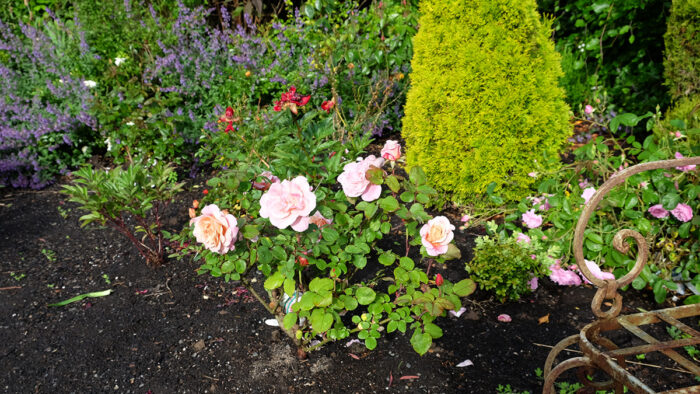
When I talk to most gardeners about roses, they often roll their eyes. Yes, roses have been around forever, and here in the Pacific Northwest they are problematic at best and often downright disappointing at worst. Even so, some of the new varieties are still worth the effort, many of which mimic antique colors and shapes.

For older roses, look for unique features
In the past I have only grown roses that had some other attribute to tempt me. I have an antique ‘Capitaine John Ingram’ purple moss rose (Rosa ‘Capitaine John Ingram’, Zones 5–9) that has nineteenth-century origins in France. I’ve also grown wingthorn rose (R. sericea subsp. omeiensis f. pteracantha, Zones 6–10) for its wicked and unique red thorns. And of course, butterfly rose (R. × odorata ‘Mutabilis’, Zones 6–9) is worth growing for its blooms that flower nonstop in many different colors.
New varieties can provide unusual colors
Last year I discovered some new varieties of roses that have wonderful, crushed colors. The term “crushed” in the rose industry refers to the bruising effect of the colors. The flowers themselves are multicolored, with different shades that fade into one another, and the flowers also fade to different colors as each bloom ages. These roses are used heavily by the floral industry. I mostly hear about them growing in the Netherlands and Sweden, but I have found some that are available in the United States and grow well here. Koko Loko™, State of Grace™, and ‘Distant Drums’ are three of these crushed roses that are growing in my garden now.

Koko Loko™ rose (R. ‘WEKbijou’, Zones 4–10) is a floribunda rose. It has a sweet, mild fragrance and a lavender-based chocolate color that starts out a lovely clear pink and ages through a single season to a brownish lavender color. It’s easy to grow and has sturdy stems for cutting.

State of Grace™ rose (R. ‘WEKspodotogi’, Zones 4–10) is a grandiflora with a fruity fragrance. It’s multicolored with apricot, rose, and salmon hues that fade to copper as flowers age. A bouquet of this rose looks like many different roses displayed together. State of Grace™ is easy to care for, and its foliage is usually spot free.

‘Distant Drums’ rose (R. ‘Distant Drums’, Zones 4–9) has a strong myrrh fragrance that is wonderful to smell on a warm day. The blooms are large with lots of petals. They are lavender on the edges with apricot and bronze centers. This is a sturdy floribunda that produces continuous blooms through the summer.
I have found those three roses to do well in my garden. Here are four tips to help you grow crushed roses successfully.
Tips for top performance
1. Give them space. I have a designated garden for crushed roses that is open with lots of light and air. Roses grown for cutting do better without other perennials and shrubs as neighbors. I have other ground cover–type roses that do better in long flower borders.
2. Prune and remove dead wood and diseased leaves in the spring and again after leaf drop in the fall. February is the time for hard pruning.
3. Fertilize with a rose fertilizer regularly.
4. Water in the morning when the water has time to evaporate instead of at night.
—Susan Calhoun is the owner of Plantswoman Design in Bainbridge Island, Washington.
Fine Gardening Recommended Products

Rain Bird PATIOKIT Drip Irrigation Patio Watering Kit
Fine Gardening receives a commission for items purchased through links on this site, including Amazon Associates and other affiliate advertising programs.

Scotts Cordless Grass-Shear/Shrub-Trimmer Combo
Fine Gardening receives a commission for items purchased through links on this site, including Amazon Associates and other affiliate advertising programs.

Attracting Beneficial Bugs to Your Garden, Revised and Updated Second Edition: A Natural Approach to Pest Control
Fine Gardening receives a commission for items purchased through links on this site, including Amazon Associates and other affiliate advertising programs.



















Comments
Log in or create an account to post a comment.
Sign up Log in